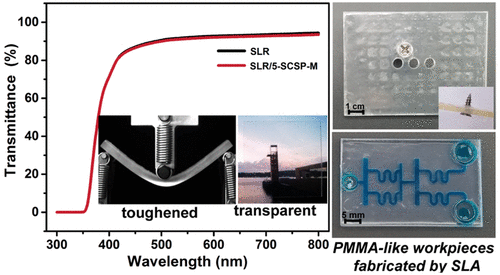当前位置:
X-MOL 学术
›
ACS Appl. Mater. Interfaces
›
论文详情
Our official English website, www.x-mol.net, welcomes your feedback! (Note: you will need to create a separate account there.)
Structure-Property Relationship of Stereolithography Resins Containing Polysiloxane Core-Shell Nanoparticles.
ACS Applied Materials & Interfaces ( IF 9.5 ) Pub Date : 2020-01-17 , DOI: 10.1021/acsami.9b20417 Yuewei Li 1, 2 , Longhui Zheng 1 , Shuqiang Peng 1, 2 , Jia-Tao Miao 1 , Jie Zhong 1 , Lixin Wu 1 , Zixiang Weng 1
ACS Applied Materials & Interfaces ( IF 9.5 ) Pub Date : 2020-01-17 , DOI: 10.1021/acsami.9b20417 Yuewei Li 1, 2 , Longhui Zheng 1 , Shuqiang Peng 1, 2 , Jia-Tao Miao 1 , Jie Zhong 1 , Lixin Wu 1 , Zixiang Weng 1
Affiliation

|
Stereolithography (SL) is an additive manufacturing technique for fabricating bulk and delicate objects layer by layer using UV-curable resin. However, epoxy-based photocurable resins used in SL printers are commonly brittle due to the high cross-linking density, thus restricting the widespread adoption of SL. In an effort to overcome this drawback, this paper details an approach of toughening the resulting workpieces by incorporating polysiloxane core-shell nanoparticles (SCSP) into an epoxy-based, photocurable formulation. This approach attempted to attain both thermal stabilities and transparency qualities comparable to that of resin without SCSP. This work systematically analyzed how the shell thickness of the SCSP impacted the final properties of the printed product. Introducing 5% w/w SCSP with a diameter of approximately 132 nm into the resin improved strain at break measured by tensile and flexural tests by 745.5 and 248.6%, respectively, and increased the fracture toughness by 166.3%. Owing to the advantages of toughness, thermal stabilities, transparency, and high accuracy of epoxy-based photocurable resin with SCSP, the 3D printing nanocomposite developed here is capable of preparing a poly(methyl methacrylate) (PMMA)-like workpiece with a commercial SL 3D printer. These results may expand the scope of the application of 3D printing in a wide variety of industries.
中文翻译:

包含聚硅氧烷核-壳纳米颗粒的立体光刻树脂的结构-性能关系。
立体光刻(SL)是一种增材制造技术,用于使用UV固化树脂逐层制造块状和易碎物品。但是,由于高交联密度,用于SL打印机的环氧基光固化树脂通常很脆,因此限制了SL的广泛采用。为了克服这一缺点,本文详细介绍了一种通过将聚硅氧烷核壳纳米粒子(SCSP)掺入基于环氧的可光固化配方中来加固所得工件的方法。这种方法试图获得与没有SCSP的树脂相当的热稳定性和透明性。这项工作系统地分析了SCSP的外壳厚度如何影响印刷产品的最终性能。向树脂中引入直径约为132 nm的5%w / w SCSP可以分别将通过拉伸和弯曲试验测得的断裂应变分别提高745.5%和248.6%,并使断裂韧性提高166.3%。由于具有SCSP的基于环氧的光固化树脂的韧性,热稳定性,透明性和高精度的优点,此处开发的3D打印纳米复合材料能够制备具有商用SL的聚甲基丙烯酸甲酯(PMMA)样工件3D打印机。这些结果可能会扩大3D打印在众多行业中的应用范围。以及具有SCSP的基于环氧树脂的光固化树脂的高精度,此处开发的3D打印纳米复合材料能够使用商用SL 3D打印机制备类似聚甲基丙烯酸甲酯(PMMA)的工件。这些结果可能会扩大3D打印在众多行业中的应用范围。以及具有SCSP的基于环氧树脂的光固化树脂的高精度,此处开发的3D打印纳米复合材料能够使用商用SL 3D打印机制备类似聚甲基丙烯酸甲酯(PMMA)的工件。这些结果可能会扩大3D打印在众多行业中的应用范围。
更新日期:2020-01-17
中文翻译:

包含聚硅氧烷核-壳纳米颗粒的立体光刻树脂的结构-性能关系。
立体光刻(SL)是一种增材制造技术,用于使用UV固化树脂逐层制造块状和易碎物品。但是,由于高交联密度,用于SL打印机的环氧基光固化树脂通常很脆,因此限制了SL的广泛采用。为了克服这一缺点,本文详细介绍了一种通过将聚硅氧烷核壳纳米粒子(SCSP)掺入基于环氧的可光固化配方中来加固所得工件的方法。这种方法试图获得与没有SCSP的树脂相当的热稳定性和透明性。这项工作系统地分析了SCSP的外壳厚度如何影响印刷产品的最终性能。向树脂中引入直径约为132 nm的5%w / w SCSP可以分别将通过拉伸和弯曲试验测得的断裂应变分别提高745.5%和248.6%,并使断裂韧性提高166.3%。由于具有SCSP的基于环氧的光固化树脂的韧性,热稳定性,透明性和高精度的优点,此处开发的3D打印纳米复合材料能够制备具有商用SL的聚甲基丙烯酸甲酯(PMMA)样工件3D打印机。这些结果可能会扩大3D打印在众多行业中的应用范围。以及具有SCSP的基于环氧树脂的光固化树脂的高精度,此处开发的3D打印纳米复合材料能够使用商用SL 3D打印机制备类似聚甲基丙烯酸甲酯(PMMA)的工件。这些结果可能会扩大3D打印在众多行业中的应用范围。以及具有SCSP的基于环氧树脂的光固化树脂的高精度,此处开发的3D打印纳米复合材料能够使用商用SL 3D打印机制备类似聚甲基丙烯酸甲酯(PMMA)的工件。这些结果可能会扩大3D打印在众多行业中的应用范围。

























 京公网安备 11010802027423号
京公网安备 11010802027423号